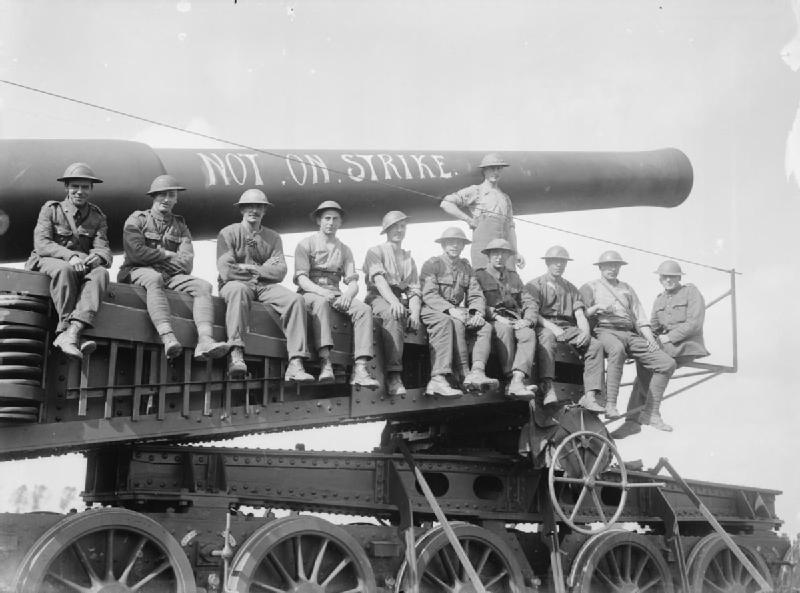BL 12-inch Railway Gun on:
[Wikipedia]
[Google]
[Amazon]
The British Ordnance BL 12 inch gun Mk IX on truck, railway mounted surplus 12 inch Mk IX W naval guns, manufactured by Woolwich Arsenal in 1906, on various railway platforms to provide mobile long-range heavy artillery for the British Army on the
 At the end of
At the end of
Western Front Western Front or West Front may refer to:
Military frontiers
*Western Front (World War I), a military frontier to the west of Germany
*Western Front (World War II), a military frontier to the west of Germany
*Western Front (Russian Empire), a majo ...
in World War I
World War I (28 July 1914 11 November 1918), often abbreviated as WWI, was one of the deadliest global conflicts in history. Belligerents included much of Europe, the Russian Empire, the United States, and the Ottoman Empire, with fightin ...
.
History
Vickers
Vickers was a British engineering company that existed from 1828 until 1999. It was formed in Sheffield as a steel foundry by Edward Vickers and his father-in-law, and soon became famous for casting church bells. The company went public in 18 ...
mounted two Mk IX W guns on slightly different railway mountings, Mk I, from September 1915. They are both identified by the open-frame appearance, recoil buffers above the barrel and the bogies with frames between the wheels similar to locomotive bogies. One mounting has a distinctive diamond-shape from the side and has a warping winch on the front; the other's carriage has a more squared-off profile with no warping winch at the front. The weapons on the Mk I mountings were originally reserve guns for HMS ''Cornwallis''.
Elswick Ordnance Company (Armstrongs) mounted two more on its own design of Mk II railway mounting, delivered to the Western Front in August 1916. They are identified by the boxed-in frame appearance, recoil buffers below the barrel and the bogies with frames outside the wheels.
Design
The gun cars allowed only 1° left and right traverse, achieved by pivoting the entire gun car body about the forward bogies, in the two Vickers carriages, or about the rear bogies in the Armstrong carriages. Like most railway guns in the war it was operated on specially-constructed curved sections of track and moved forward or backward to point it at a new target. Fine adjustment could then be achieved by onboard traversing, which at the gun's maximum range covered an arc of about . The initial shock of firing was absorbed by a hydro-spring mechanism, allowing of recoil within the gun mounting. The remaining recoil energy was absorbed by allowing the entire railway wagon to roll backwards (Vickers carriage) or (Armstrong carriage) against locked brakes. This "rolling recoil" system allowed the gun to be operated without the need to construct a pit with a strong static platform below the gun for it to recoil into and to allow transmission of all the recoil force directly to the ground as was typical of many large US and French railway guns.Combat service
 At the end of
At the end of World War I
World War I (28 July 1914 11 November 1918), often abbreviated as WWI, was one of the deadliest global conflicts in history. Belligerents included much of Europe, the Russian Empire, the United States, and the Ottoman Empire, with fightin ...
, the dispositions of the guns on the Western Front Western Front or West Front may refer to:
Military frontiers
*Western Front (World War I), a military frontier to the west of Germany
*Western Front (World War II), a military frontier to the west of Germany
*Western Front (Russian Empire), a majo ...
were: 1 gun of 92 Battery and 1 gun of 543 Battery with First Army i.e. Artois; 1 gun of 92 Battery with Third Army i.e. Somme; 1 gun of 543 Battery with Fourth Army i.e. Somme.
See also
*List of railway artillery
Railway guns were large guns and howitzers mounted on and fired from specially constructed railway cars. They have been obsolete since World War II and have been superseded by tactical surface-to-surface missiles, multiple rocket launchers, and ...
* BL 12 inch Mk IX naval gun
Weapons of comparable role, performance and era
*Canon de 305 mm Modèle 1893/96 gun
The Canon de 305 mm Modèle 1893/96 was a heavy naval gun used as the main armament of a number of French pre-dreadnoughts during World War I. It equipped the ''Charlemagne'', ''République'' and ''Liberté''-class battleships as well as t ...
French equivalent railway gun
Notes
References
Bibliography
* * * * *External links
* {{DEFAULTSORT:Bl 12 Inch Railway Gun World War I railway artillery of the United Kingdom Railway guns 305 mm artillery